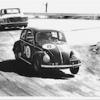
Forgive me for such fluff within TNF but I know that many racers just like nuts and bolts. Yesterday with some friends we had a Last of
the Summer Wine day out at the Portsmouth Historic Dockyard and Submarine Museum. It would take a stony heart indeed not to appreciate
the handsome lines of what was in the mid-19th Century the most powerful and innovative warship of its day - HMS Warrior...built 1860...the first
great RN iron-hulled, armour-plated steam/sail hybrid...Gawd bless 'er.

Down in the engine room - Warrior's replicated two-cylinder steam engine, her original having been made by John Penn and Sons, was turning over when I took this shot.
The crankshaft is fully exposed, the cylinders offset to the ship's port side - the power unit's great weight is offset by a massive fresh water tank
to starboard - left in this rear-facing shot - for conversion to and condensation from steam. Indicated horsepower was 5,772 (4,304 kW) giving the ship with its single, two-bladed propeller
(which alone weighed 26 tons), a speed of 14.08 knots (26.08 km/h; 16.20 mph) under steam only.
With bunkerage for some 860 tons of fine Welsh anthracite (well, that's what the man said) she could steam 2,100 nautical miles (3,900 km; 2,400 mi) at 11 knots.
Under sail alone Warrior still managed 13 knots (24 km/h; 15 mph).

Across Portsmouth Harbour in the fabulous Submarine Museum at Gosport we had a look around the Navy's first submarine -
Holland 1.
Nestled in her aft compartment is this Brayton engine. It's in such a badly corroded state because in 1913, while under tow to
the shipbreaker,
Holland 1 foundered near the Eddystone lighthouse. The wreck was located in 1981 and raised in 1982. Now she makes a wonderfully evocative exhibit.

Here's her interior - eight men manned her in her heyday. Rather them than me. That's her single torpedo tube to the left, opening to the sea through the bow.

Spool forward a few decades and in 1944 four men manned this X-craft midget submarine - X24 - to attack a strategically important floating dock in Bergen harbour, Norway.
The attack succeeded in sinking a 7,000-ton freighter named the Barenfels instead. One of my neighbours was a veteran of the midget submarine service, a
pioneering instructor 1942-45. He passed away last week. There, friends, was one of a different Few - heroes seldom recognised and appreciated...

This is the Gardner 4-cyl diesel engine of X24 - for use when submerged she was also equipped with a 30hp Blackman electric motor. Crewmen had to be compact,
none too sensitive to heat, noise, movement and danger, but also immune to claustrophobia.

Fore-end of a full-size Das Boot - HMS Alliance, the 1945-launched A-class boat at Gosport. This large torpedo storage compartment
also doubled as convenient accommodation for embarked special service troops, frogmen, agents etc when such boats were deployed - as they
often were - on cloak and dagger survey, assault and raiding duties.
The for'ard torpedo tubes are visible through the twin water-tight doors.

Control room centre-ship beneath the conning tower in its 1970s streamlined fin up there way above our heads. Periscope to the left,
bewildering tank-blowing/flooding controls, well, everywhere.

As above - a triumph of wartime Naval ergonomic design - hem, hem...

Engine room - Alliance is powered by two 2,150 hp supercharged Vickers 8-cylinder diesels for surface use or when running underwater
with the snort air intake mast raised, while for deeper running below Snort range she relied upon two 625 hp electric motors. With two shafts
and propellers she could make just over 18kts surfaced, or 8kts submerged. Range was to my mind amazing - 10,500 nautical miles (19,400 km)
at 11 knots (20 km/h) surfaced.

Driving position with a difference. Those black curved beams immediately ahead are the enormous 2150hp engine's exposed rocker-arms. Imagine them all
rocking away at the power unit's 450rpm cruising speed. Ear defenders over ear plugs over terminal stone deafness, de rigeur...all amid fantastic
temperatures and the all pervasive pong of diesel and hot metal, and sweat. With fresh water conservation critical on board, HM S/M Alliance had no showers
for the crew of around 70. The Silent Service deployed tolerant people.

After end and the sting in her tail - two more torpedo tubes. She carried 21-inch diameter torpedos, mainly in service the age-old RN Mark VIIIs
I believe which were good for a range of 7,000 yards (6,400 m) at 41 knots, conveying an 805 lb (365 kg) Torpex-packed warhead to its target. Oh my...fascinating
to see, knowing that - for us as mere visitors - the luxury of the sunlit outdoors and great lungfuls of fresh air were always mere seconds away.
All photos Strictly Copyright: The GP Library
Edited by Doug Nye, 28 July 2013 - 15:53.






































